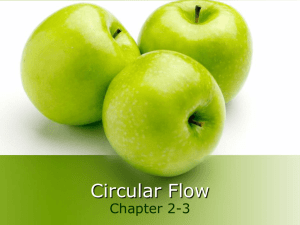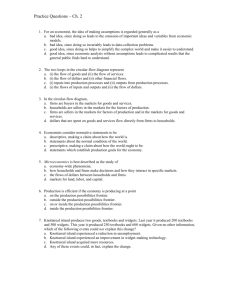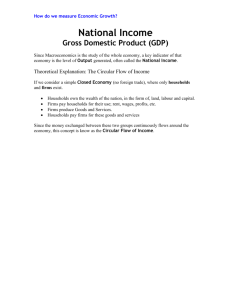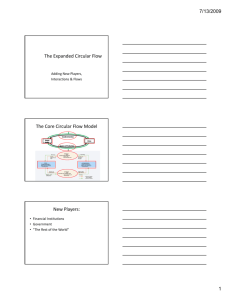Circular Flow of Economic Activity
advertisement
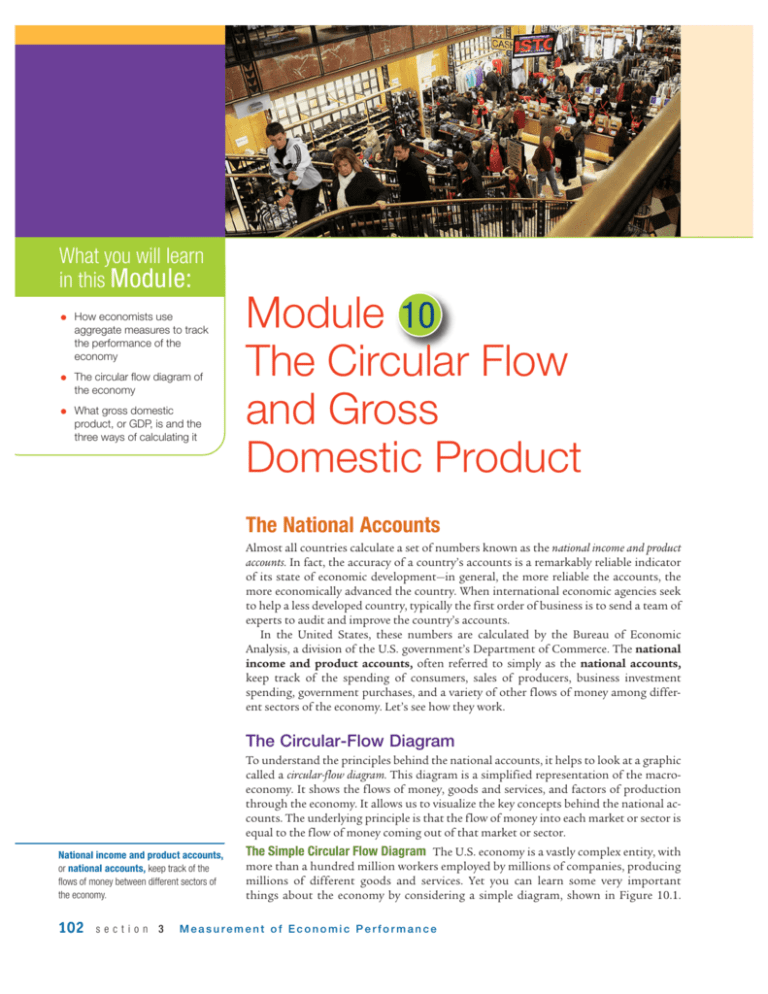
What you will learn in this Module: • How economists use aggregate measures to track the performance of the economy • The circular flow diagram of the economy • What gross domestic product, or GDP, is and the three ways of calculating it Module 10 The Circular Flow and Gross Domestic Product The National Accounts Almost all countries calculate a set of numbers known as the national income and product accounts. In fact, the accuracy of a country’s accounts is a remarkably reliable indicator of its state of economic development—in general, the more reliable the accounts, the more economically advanced the country. When international economic agencies seek to help a less developed country, typically the first order of business is to send a team of experts to audit and improve the country’s accounts. In the United States, these numbers are calculated by the Bureau of Economic Analysis, a division of the U.S. government’s Department of Commerce. The national income and product accounts, often referred to simply as the national accounts, keep track of the spending of consumers, sales of producers, business investment spending, government purchases, and a variety of other flows of money among different sectors of the economy. Let’s see how they work. The Circular-Flow Diagram To understand the principles behind the national accounts, it helps to look at a graphic called a circular-flow diagram. This diagram is a simplified representation of the macroeconomy. It shows the flows of money, goods and services, and factors of production through the economy. It allows us to visualize the key concepts behind the national accounts. The underlying principle is that the flow of money into each market or sector is equal to the flow of money coming out of that market or sector. National income and product accounts, or national accounts, keep track of the flows of money between different sectors of the economy. 102 section 3 The Simple Circular Flow Diagram The U.S. economy is a vastly complex entity, with more than a hundred million workers employed by millions of companies, producing millions of different goods and services. Yet you can learn some very important things about the economy by considering a simple diagram, shown in Figure 10.1. Measurement of Economic Performance Section 3 Measurement of Economic Performance figure 1 0 .1 The Circular-Flow Diagram This diagram represents the flows of money and goods and services in the economy. In the markets for goods and services, households purchase goods and services from firms, generating a flow of money to the firms and a flow of goods and services to the households. The money flows back to households as firms purchase factors of production from the households in factor markets. Money Households Goods and services Money Factors Markets for goods and services Factor markets Goods and services Money Factors Firms This simple model of the macroeconomy represents the transactions that take place by two kinds of flows around a circle: flows of physical things such as goods, services, labor, or raw materials in one direction, and flows of money that pay for these things in the opposite direction. In this case, the physical flows are shown in yellow, the money flows in green. The simplest circular-flow diagram illustrates an economy that contains only two kinds of “inhabitants”: households and firms. A household consists of either an individual or a group of people who share their income. A firm is an organization that produces goods and services for sale—and that employs members of households. As you can see in Figure 10.1, there are two kinds of markets in this simple economy. On one side (here the left side) there are markets for goods and services (also known as product markets) in which households buy the goods and services they want from firms. This produces a flow of goods and services to the households and a return flow of money to firms. On the other side, there are factor markets in which firms buy the resources they need to produce goods and services. The best known factor market is the labor market, in which workers are paid for their time. Besides labor, we can think of households as owning and selling the other factors of production to firms. This simple circular-flow diagram omits a number of real-world complications in the interest of simplicity. However, it is a useful aid to thinking about the economy— and we can use it as the starting point for developing a more realistic (and therefore more complicated) circular-flow diagram. The Expanded Circular-Flow Diagram Figure 10.2 on the next page is a revised and expanded circular-flow diagram. This diagram shows only the flows of money in the economy, but is expanded to include extra elements that were ignored in the interest of simplicity in the simple circular-flow diagram. The underlying principle that the inflow of money into each market or sector must equal the outflow of money coming from that market or sector still applies in this model. In Figure 10.2, the circular flow of money between households and firms illustrated in Figure 10.1 remains. In the product markets, households engage in consumer spending, buying goods and services from domestic firms and from firms in the rest of the world. Households also own factors of production—land, labor, and capital. module 10 Money A household is a person or group of people who share income. A firm is an organization that produces goods and services for sale. Product markets are where goods and services are bought and sold. Factor markets are where resources, especially capital and labor, are bought and sold. Consumer spending is household spending on goods and services. The Circular Flow and Gross Domestic Product 103
